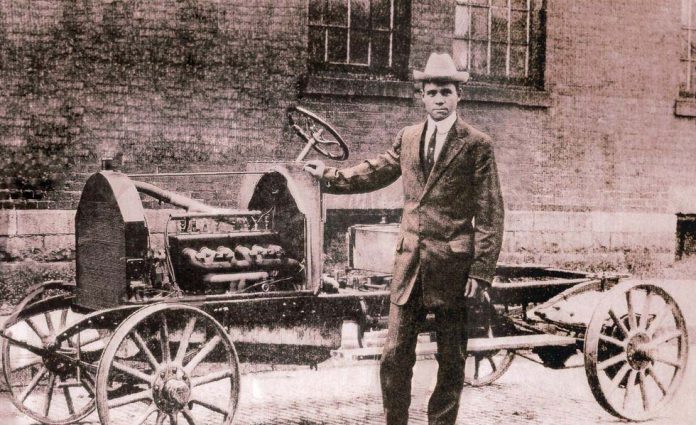
By Maggie McBride
As Black History Month comes to a close, it’s important to continue to reflect on the contributions black Americans have made to our nation all year. The truth is that so many things about the everyday lives of people in this country would be different without the groundbreaking work of black inventors, scientists, and entrepreneurs, and the automotive industry is no different. From lesser-known names to famous innovators, the impact that black Americans have had on the automotive industry is wide-reaching, from engineering, features, and entrepreneurship.
There From the Beginning
When discussing people who paved the way in automobile manufacturing, Henry Ford is the first name that frequently jumps to mind. However, in 1873, a former slave named Charles Richard Patterson teamed up with J.P. Lowe to form a carriage business after a history in blacksmithing, and once both partners passed away, the business went to Patteron’s son, Frederick, in 1910. This was right on the cusp of the explosive success of the automobile, and Frederick Patterson, recognizing the future of the horseless carriage, converted C.R. Patterson & Sons Company to a car manufacturer. The first Patterson-Greenfield car hit the road in 1915, powered by a four-cylinder Continental engine that made it comparable to the Model T. Its construction came after years of offering their services in a mechanic capacity, learning the ins and outs of the mechanical and electrical systems. In a quote attributed to publicity efforts for the Patterson-Greenfield car, C.R. Patterson & Sons managed to craft a timeless summary of car shopping and marketing all at once:
“Our car is made with three distinct purposes in mind. First — It is not intended for a large car. It is designed to take the place originally held by the family surrey. It is a 5-passenger vehicle, ample and luxurious. Second — It is intended to meet the requirements of that class of users, who, though perfectly able to spend twice the amount, yet feel that a machine should not engross a disproportionate share of expenditure, and especially it should not do so to the exclusion of proper provisions for home and home comfort, and the travel of varied other pleasurable and beneficial entertainment. It is a sensibly priced car. Third — It is intended to carry with it (and it does so to perfection) every conceivable convenience and every luxury known to car manufacture. There is absolutely nothing shoddy about it. Nothing skimp and stingy.”
Unfortunately, a small company making carefully crafted vehicles could not keep up with the demand for new cars that were competitively priced and made more quickly. It is estimated that only 150 cars were made by C.R. Patterson & Sons, and that none are still around today. When the company closed its doors in 1939, it was as a small business falling victim to the Great Depression.
Just a few years later in 1942, the one and only George Washington Carver, famed for his numerous inventions and innovations in agriculture, was invited to Dearborn, Michigan to collaborate with Henry Ford after several years of brainstorming and friendship. The aim was to apply Carver’s love of biofuel and plant derivatives to figure out a synthetic rubber alternative to compensate for wartime shortages. Ultimately, they figured out a substitute derived from goldenrod. The admiration between these two minds was evident in that Henry Ford donated to the Tuskegee Institute and financially assisted with many of Carver’s experiments.
A more obscure name in vehicle innovation is Richard Spikes. Though he might not have the profile enjoyed by C.R. Patterson, Frederick Patterson, or George Washington Carver, his many range of inventions (not just limited to automotive) are still significant. Spikes is credited with patenting the gear shift for automatic transmissions in 1933, which was a huge leap forward in the convenience of driving. Spikes received over $100,000 in the 30s for the use of the invention, which helped him work towards his next big project: an automatic safety brake system, which was his final patent before he died in 1963.
The Must-Haves
There are vital components of every car and it’s hard to imagine vehicles without them, so it’s interesting to find out which of them have been created by unsung black inventors. For example, take your car’s air purification system: it makes every ride exponentially more enjoyable (who wants to spend every drive breathing in other cars’ exhaust fumes?), and it was invented by Dr. Meredith Gourdine. Gourdine was an accomplished athlete, engineer and physicist known for his work in electrogasdynamics, but is best known for inventing “Incineraid,” a system designed to remove smoke from buildings. His work led to what is now known as the catalytic converter, which reduces vehicle emissions. In fact, they are carefully monitored by the EPA for their critical role in keeping an automotive carbon footprint at bay, and it all stemmed from the brilliant mind of a black inventor.
A quick question: what’s an absolutely critical feature on a car that people definitely don’t use enough? If you answered a turn signal, you’d be correct, and it was invented by Florence Lawrence, a black actress and car enthusiast who bought a car in 1913 and immediately thought of ways to improve it. Her very early version of the turn signal wasn’t a light like it is now. According to Lemelson-MIT, “her variation was an arm placed on the back of the car’s fender that could be activated to rise or lower with the push of buttons located by the driver’s seat to indicate the driver’s intention to turn left or right.” She also invented a full-stop indicator, paving the way for the brake light. She never patented the inventions, but their value was not underestimated. In fact, these ideas were quickly adapted and improved by auto manufacturers, and integrated into every vehicle rolling off the line.
In addition to being responsible for some of the critical automotive components that have resulted in huge leaps forward, there are some things that are more “auto-adjacent” that have revolutionized the industry as well, all thanks to black inventors who saw potential and knew how to realize it. For example, in the early 1920s, a Kentucky native named Garrett Morgan born to former slaves witnessed a terrible traffic accident. Such things were inevitable as various modes of transportation had to share the road somewhat lawlessly in the early days of vehicles, but Morgan got thinking, and in 1923 he was granted a patent for the first mechanical three-position traffic signal. It was an elegant solution to the problem that was plaguing a nation where vehicular popularity was exploding. The current traffic signal had two settings: stop, and go. Adding one more and giving drivers/pedestrians/carriages time to use their judgment to figure out if they had time to stop was a game-changer and greatly increased safety on the road.
A Notable Automotive Entrepreneur
Inventors and engineers put together the automobile, and entrepreneurs marketed and sold them to the everyday person. Homer Roberts was a World War I veteran who was the first black man to receive the rank of Lieutenant in the Army Signal Corps. He was also the first black car dealership owner, starting up a business in 1919 simply by taking out an ad in the paper. Roberts worked exclusively to broker deals for the black community and eventually founded Roberts Motors, the success of which led to obtaining a Ford franchise not too far from the setup that dealerships still have: a plentiful showroom, a parts store, and a repair shop. It was immensely successful, and soon he added other brands to his lot and even opened a second location.
Are you the next landmark minority-owned dealership? The National Association of Minority Automobile Dealers (NAMAD) has a dealer locator that makes it possible to look up where minorities run dealerships in your state, so if your dealership isn’t listed, be sure to contact them.
Black history month is confined to February, but the support of underrepresented communities should be a year long effort. We have these inventors and so many more to thank for the safety, smooth running, and improvement of the automobiles we send out on the road every day. Take the final days of February to note and celebrate their amazing work!












